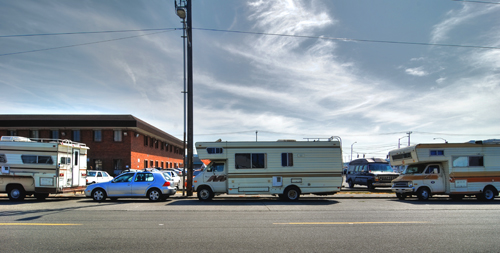Our cabinet shop resides in an area of town where several industrial and residential zones meet. Subsequently there are a variety of activities and much diversity within the built environment. Amongst all of this we’re noticing an odd trend lately; more and more people are living in mobile dwellings parked on the side of the streets. Whether it’s campers on the back of pickups, camper-vans or RVs, these mobile units are for all intents and purposes “home” for a growing population.

Here at the BUILDblog we can’t help but be intrigued with the real, down and dirty solutions that society is finding in the current housing crisis. With mortgages difficult to obtain, ridiculous housing prices in the city, and the need to be close to work, the equation is producing answers whether they are socially agreeable or not.
Having witnessed several housing solutions fail in the last decade, we got curious about the viability of mobile dwellings. So we decided to pick them apart with an architectural lens in terms of cost, community and aesthetics.
COST
We took a look at ball-park prices and came up with a quick cost matrix. Three types of mobile dwellings are compared to each other and to a “typical” single family home in the region. The cost information for the mobile dwellings are used prices rather than new – we’ve assumed that this would be the more likely scenario.

While all of the mobile dwelling types are much more accessible price-wise, two out of three are a fraction of the cost per square foot – even with the drastically reduced area (we were actually surprised that the numbers didn’t scale closer). There are other cost factors of course; the mobile dwellings require generators and additional work to supply water and fuel and remove waste. As per the City of Seattle code, “vehicles” can only be kept in one place for a maximum of 72 hours, adding to fuel costs for the vehicle and occasional maintenance.
COMMUNITY
We debated this quite a bit and concluded that, just like any neighborhood where the dwellings don’t move, the success or failure of the community depends entirely on the people. There is a correlation between more eyes on the street and security, as Jane Jacobs made a case for in The Death and Life of Great American Cities. Having a residential presence within some of these industrial areas has advantages during non-business hours. The flip side of the coin is, obviously, whether the people living in their vehicles are keeping an eye out for trouble or are they making trouble themselves.
AESTHETICS
There are terrible looking mobile dwellings and others that look perfectly fine. Honestly, some of the mobile homes around the neighborhood are better designed and maintained than some of the buildings. In short, the nature of the mobile dwelling itself is not a visual conflict for us.
As with any factor in the design and construction industry, we have a certain appreciation for real-world resolutions to the many variables out there. Like it or not, the number of mobile dwellings is increasing. And whether it’s respectable to people or appalling, mobile dwellings are solving the problem of housing for this population. Maybe it’s simply the path of least resistance but this response to the housing crisis has our full attention. We’d love to hear your thoughts.
Information sources: Camping world, Auto Trader, Trulia, DQ News





